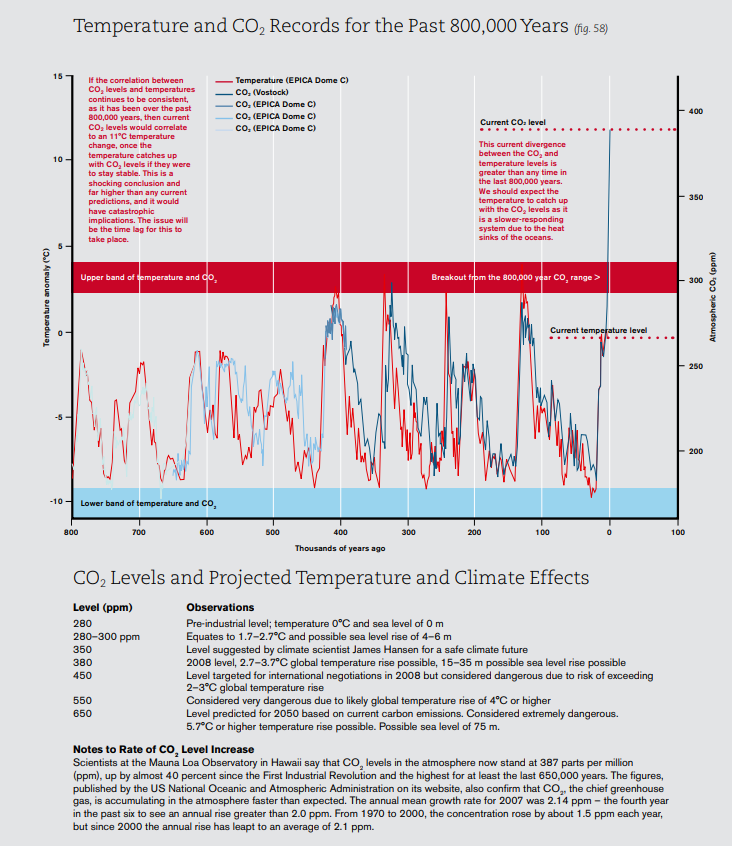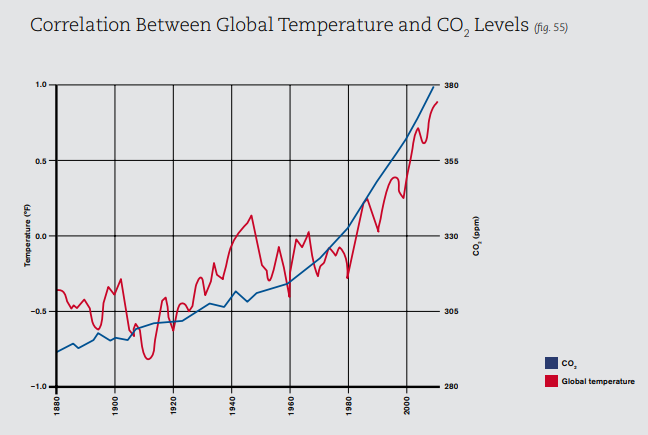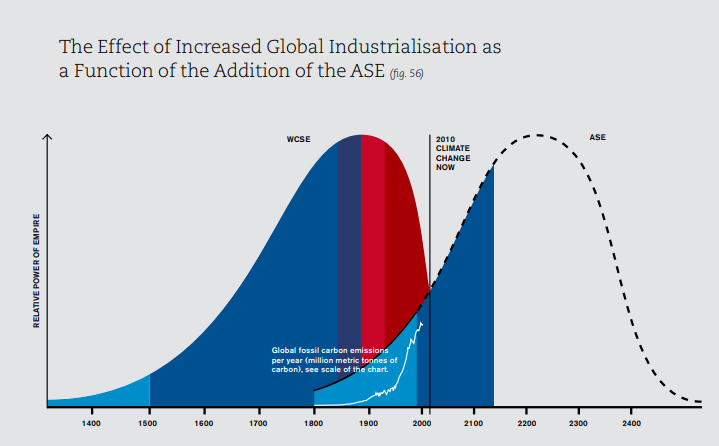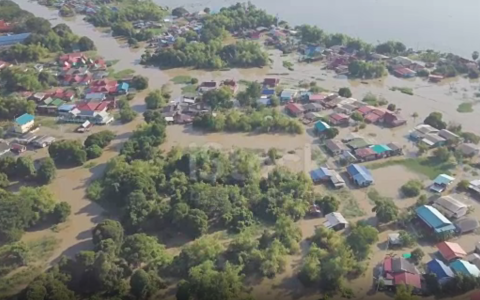My analysis of the reality of climate change and its profound impact on our habitat on Earth was covered in a specific chapter of Breaking the Code of History. Written at a time when many doubted climate change was anything more than an arbitrary oscillation in temperature, my thesis has proven frighteningly prescient. It is included below as written a decade ago.
Climate change is a clear and present danger to our Human civilisation, and yet we are preoccupied with national rivalry and short term self-interest.
Summary of action points
- We have built-in an 11-degree temperate change in one single image of Co2 versus Temperature over 800,000 years of ice cores we highlighted that at 390 PPm (now in excess of 415ppm). We have already built in an inevitable 11 degree plus temperature change into our environment which is catastrophic. The only question is how quickly the heat sinks of the world absorb this energy before the atmosphere accelerates its warming rate.
- Reaching a state of zero Global emissions will not affect this catastrophic outcome.
- We need to extract Co2 and methane on a significant level from the atmosphere and terraform our environment back into the top end of the 800.000 range at 300PPm.
- We need to adopt The Californian, CO2 and Hydrogen tariff system globally to swiftly encourage new technologies of Carbon sequestration.
- Climatic consequences - higher average wave heights, consistently increasing energy in our weather systems, literal flooding as sea-levels rise and local weather systems create storm surges and flooding. Droughts and famine as food supply chains are interrupted.
- When will we change our ways?; only when major cities like London and New York are flooded will realise that change is our only option for survival.
Climate change is measured against the climate in 1800 at the start of the first industrial age. To understand the effects of the changes as the temperature increases, it helps to look at the effects in 1°C increments:
+1°C represents a 0.3°C rise from the current 0.7°C level, leading to an acceleration of all of the present climate-change trends: higher levels of greenhouse gases, melting ice, deforestation and desertification.
+2°C is the level that the Kyoto Protocol was designed to defend against. However, this rise is now seen to be inevitable, although with the time lag between temperature change and greenhouse-gas trends, it will probably be reached sooner than forecast. A world 2°C warmer will be blighted by equatorial deserts, although in Northern Europe increased warmth could improve agricultural outputs.
+3°C is the level at which the Alps will have lost all snow and glaciers, there will have been widespread wildlife extinctions on land and in the oceans, sea levels will be consistently higher than expected and coastal cities will suffer from storm surges.
+4°C will cause heatwaves in Northern Europe, the rainforests will be disappearing, and the melting of the Greenland ice cap, along with meltwater from the Antarctic, will cause sea levels to rise by 7–14 m, changing the geography of all landmass.
+5°C will lead to global crop failure
Extracts from Breaking the Code of History 2010
Climate Change in Context
‘Climate change’ is now a common phrase, yet few people understand the changes to the Earth’s biosphere or their historical context. Indeed, there are still those who refute its very occurrence despite significant and incontrovertible evidence to the contrary.
It has become possible to make longitudinal assessments of the Earth’s past temperatures from the study of ice cores up to 400,000 years old that contain trapped air bubbles dating from when the ice was formed. The study of these air bubbles, particularly of the heavier isotopes of hydrogen and oxygen, can reveal average temperatures and levels of environmental carbon dioxide (CO2 ) and methane. This information allows us to place today’s climate in a historical context.
The Earth’s temperature has varied within a 13°C range during a time period of 90,000–110,000 years, the low points marking the ice ages and the high points the warm phases. It is noticeable that the cooling phases were gradual, with average declines of 1°C over 10,000–12,000 years, while the phases of warming were much sharper, with each jump of 10–13°C taking roughly 10,000 years.
The last ice age ended some 18,000 years ago, and over the next 6,000 years the temperature rose by 8°C at a rate of 1°C every 750 years, to reach current levels. Temperatures were relatively stable for the next 10,000 years, varying only in a range of plus or minus 1°C. It was this warm and stable environment that provided the optimum conditions for the growth of civilisation.
Since 1900, when reliable temperature records were begun, land temperatures have risen by 0.9°C and those of the oceans by 0.5°C. The seas are in effect the heat reservoir of the planet. Slower to respond to atmospheric temperature changes than the land, they act as a stabilising element for the temperature of the biosphere. However, once they begin to warm, momentum will hold those temperature changes for some time, delaying their overall cooling.
To put the current average 0.9°C increase into perspective, this represents 1°C every 140 years – which is five times as fast as the rate of 1°C per 750 years that followed the last ice age. Current climatic modelling suggests that a temperature rise of more than 2°C would create the potential for a climatic shift of major proportions. Taking a linear view, if we extrapolate the current rate of change into the future, we should expect to reach the temperature risk point by 2180. However, the Earth’s atmosphere is not a linear system, and all of the evidence suggests that it is now undergoing an accelerating rate of change. Indeed, eleven of the last twelve years rank as the warmest since 1850. It is therefore highly likely that the catastrophic effects of climate change will become increasingly evident in the much shorter term.
Climate Change and the Earth’s Past
The concept of climate change has become one of the hottest political topics of the first decade of the twenty-first century. However, before we examine the evidence and potential consequences, it is worth stepping back to gain a bigger perspective.
The universe is around 6 billion years old and the Earth approximately 4 billion years old. During its long life, the Earth has cooled from a hot, molten mass to a lush planet of which 75 percent of the surface is water.
Some 550 million years ago, after 200 million years of glaciation, the Earth was icebound. Then a giant volcanic eruption suddenly raised CO2 levels to 12 percent of atmospheric gases – 350 times current levels. This brought an end to the Precambrian period and led to the Phanerozoic period of warmth, which gave rise to simple multicellular life, followed by more complex plants and animals. Atmospheric CO2 levels were ten times today’s concentrations, dropping to four to six times in the Mesozoic era and rising to ten to fifteen times at the start of the Devonian period. This latter era, some 400 million years ago, witnessed the extensive spread of plants, which reduced CO2 concentrations significantly and stabilised the atmosphere.
For millions of years, the Earth has evolved and hosted numerous ecosystems, each with its own adaptations to the prevailing climatic conditions. So when we talk emotively about ‘saving the planet’, we reveal the egocentricity of our species. Earth will survive, even after we have finished destroying the ecosystem that gave us life. Indeed, we may simply be fulfilling a role similar to that of the asteroids that acted as an instrument of change in prompting the next phase of the Earth’s history. Viewed from this perspective, talk of ‘saving the planet’ really translates into ‘saving ourselves’.
During the 1990s, the initial observation of scientists – that the Earth was undergoing a climatic shift – were met with general scepticism. This was founded upon the premise that there have always been fluctuations in global weather patterns, and we simply did not have sufficient historical context to understand the current temperature variations. For reasons we will consider later, opposition to the concept of climate change has been consistent and relentless. Thankfully, there has been a mass of scientific work, foremost of which was the analysis of the 400,000-year-old ice cores mentioned earlier, which have given scientists a clear understanding of historical levels of atmospheric greenhouse gases. Furthermore, the relationship between the levels of particular atmospheric gases (including CO2 ) and global temperatures has now been clearly established (see Figures 55 and 58). Extrapolating from this relationship, it is clear that the increased human population and associated industrialisation are causing an increase in atmospheric levels of greenhouse gases and, hence, global warming.
Analysis of CO2 levels within the last 110,000 years clearly shows a natural variation of between 180 and 300 ppmv (parts per million by volume) until the middle of the twentieth century. The lower levels of CO2 correlate to the ice-age cycles, the last of which reached its peak some 18,000 years ago. Since then, the planet has been warming, resulting in an environment conducive to the expansion of the human population.
However, despite our relentless expansion, by the 1800s the world’s economies were still largely agrarian and only 3 percent of the population lived in cities. During this period, the average temperature of the planet was 14°C. At the end of the first decade of the twenty-first century, following the First Industrial Revolution and the start of the second, the average temperature of the planet is 15°C.
As the Second Industrial Revolution unfolds, a staggering 3.2 billion people (50 percent of the Earth’s population) now live in cities. By 2030, this is projected to reach 5 billion (60 percent). By 2020, the world is expected to have nearly 500 cities with more than 1 million citizens, with the majority having more than 5 million and the ten largest containing more than 20 million. Given the weight of evidence that urbanisation and industrialisation are both responsible for the dramatic increase in CO2 levels that are changing our climate, we can expect that trend not simply to continue but to accelerate.
Industrialisation compounds our influence on the environment by many multiples. The climatic changes wrought by the developed world as a result of the First Industrial Revolution have, to a large extent, been absorbed by the Earth’s ecosystem.
However, as the emerging empires of the East seek to emulate the lifestyle of the WCSE, the additional carbon outputs from their rapid industrialisation is tipping the balance of the Earth’s closed ecosystem. For all practical proposes, we have already passed the point beyond which the biosphere of our planet has been destabilised. The danger now is that this process of change has its own momentum that will only cease when it finds a new equilibrium. Undoubtedly, that equilibrium will result in a planetary ecosystem very different from that of the last 800,000 years.
Our overpopulation of the Earth is alarming at present but is expected to reach a staggering 9.2 billion by 2050. Without having the option of space travel, we are more like the territorially constrained mice of Australia than the lemmings that at least have the option of escaping their immediate overpopulated environment. As such, we now face the consequences of our success and will have to cope with the severe climatic changes that we have induced. This will add massively to the social stress of our overpopulated planet. The message is clear: climate change and population expansion are inextricably linked, and the solution, if we choose to genuinely attempt to work towards one, will involve some radical changes to the way we live.
Climate Change and the Cycles of Empire
Climate change has not occurred at some arbitrary point but at a specific phase in our history – as the First Industrial Revolution segues into its successor. As we have seen, the US – the last offspring of the WCSE – peaked in 1990 and has since been in decline. Thus it is safe to suggest that the response of the developed nations of the WCSE to the problem of climate change has been shaped by the psychology typical of decline and overextension, in which it has become an ever-increasing challenge to maintain the high standard of living that the developed nations have come to expect and demand of their politicians. This being the case, the diversion of public resources to counter climate change, and the reduction in lifestyle and choice that would be required on an individual level, are both likely to meet with substantial resistance.
This resistance is compounded by a society set in its ways and unable to adapt effectively to new challenges, the interest of a declining empire being the maintenance of the status quo. In addition, the decline in creativity of a waning empire further limits its range of responses, new problems being met with old solutions. Furthermore, empires in decline face immediate threats from rising empires, and these take precedence over future, less tangible dangers.
Thus the US, invested in consumption and heavily reliant on oil, has been slow to respond to the threat of climate change. Its response has been partially mitigated by that of Europe. Being in legacy and reformation, and therefore not as overstretched as the US, it has been one of the most responsive territories to the dangers of climate change and the protocols of Kyoto and Copenhagen.
The populations of the WCSE are now in decline, consistent with its decline in empire. In contrast, the emerging nations in regionalisation, such as Africa, India, Latin America and the Middle East, and those in ascension to empire, such as China, are expanding demographically. As has been posited, these nations have a single goal: to expand and emulate the standard of living of the developed world. As yet, the poverty of the majority of the emerging nations means that the day-to-day challenges of existence override the concerns of climate change. However, it is these nations, currently building new modern infrastructures, that could theoretically be capable of integrating green technologies into their growing economies if the cost differential were compensated for by the developed nations. Without such support, the emerging nations are unlikely to opt for cleaner energy, justifying their CO2 emissions by accusing the developed world of creating the problem in the first place. The net effect is a great deal of talk but no action of the magnitude that is urgently needed to address the current changes to the climate.
Where the metal meets the road-sea level
Climate change will bring many changes to our environment, many requiring major human adaptation. However, there is on a consequence that will have the highest impact of all. Sea level changes. Since the last ice age, sea levels fell by some 160M. When all the land ice melts as it inevitably will do sooner than we expect, coupled with the effects of thermal expansion then we could see a reversal of sea levels of the same order of magnitude. When only a few meters rise in sea level would flood many of our major cities, disaster is far closer than many recognise. A time frame of less than one or max two decades rather than the slow estimates of centuries.
Technologies that could make a difference
- Nuclear Fission Power-Run a campaign to remove the greens prejudice against this power source.
- Wind Power –low cost
- Solar Power-low cost
- Nuclear Fusion Power –The ultimate solution in the UK its called STEP (spherical tokamak for energy production). It will start testing in 2040 and meanwhile in France ITER International thermonuclear experimental reactor) will start testing in 2025
Mitigations
- Flood barriers.
- Carbon neutral technology.
- Building a hydrogen economy.
Climate Reversal or Geo-Forming technology
The magnitude of the challenge is enormous as it would require removal of 20 Bn tonnes of carbon per year for 100 years fro 410 PPM to 310 PPM
Carbon negative technology-carbon capture technologies with potential are;
- Clean Energy Systems energy production and carbon capture/sequestration.
- Blue Planet –Carbon capture into rock?
- Plant forests of fast growing trees and Kelp fields
- Solar radiation management SRM-Block/reflect sunlight to keep cool.marine cloud brightening using saltwater sprays...




















